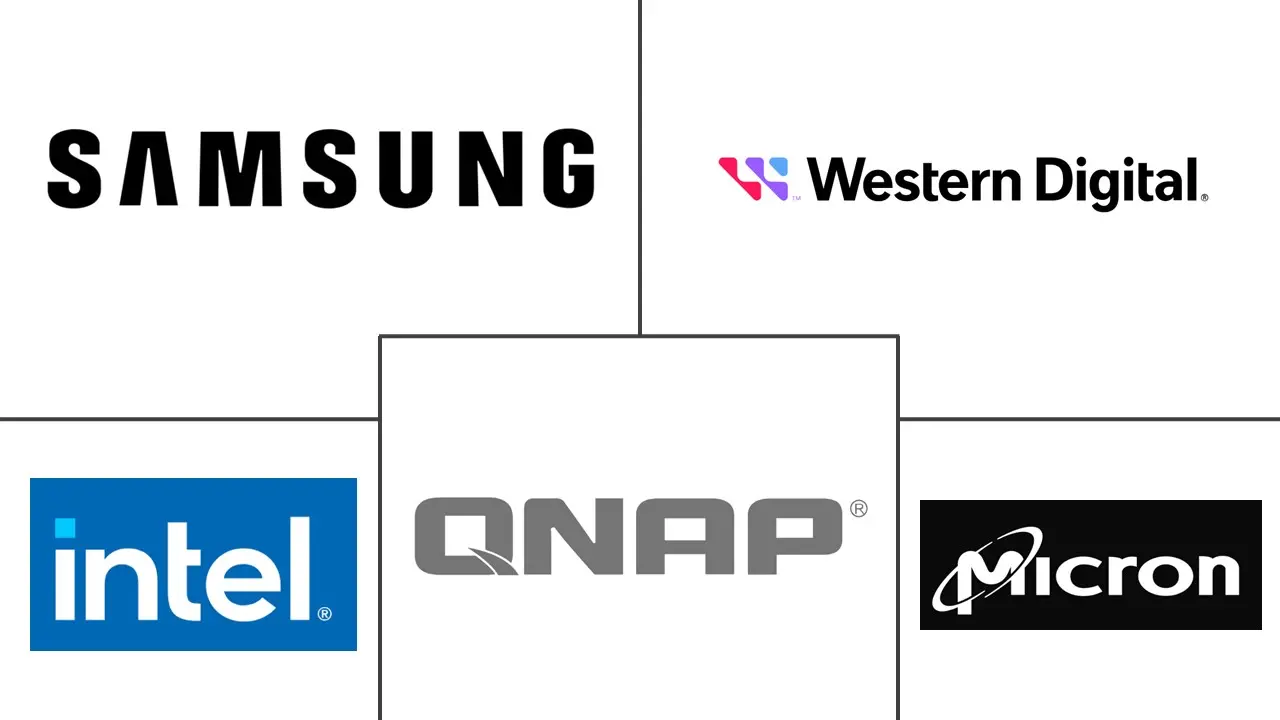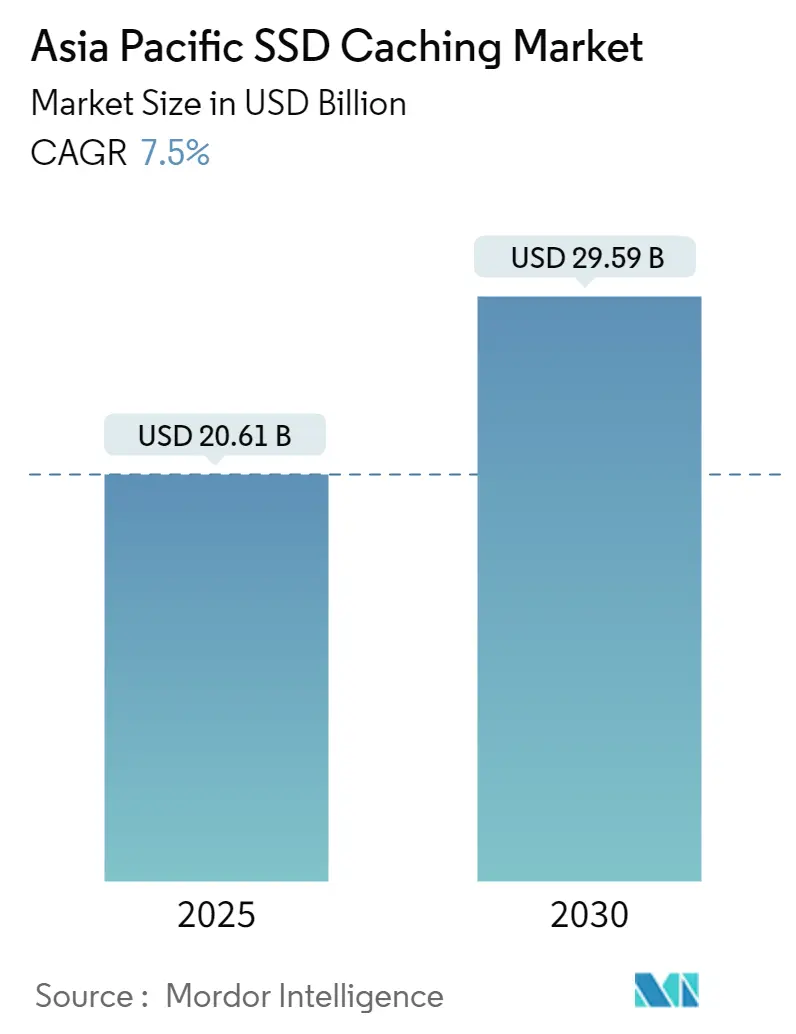
Asia Pacific SSD Caching Market Analysis by Mordor Intelligence
The Asia Pacific SSD Caching Market size is estimated at USD 20.61 billion in 2025, and is expected to reach USD 29.59 billion by 2030, at a CAGR of 7.5% during the forecast period (2025-2030).
SSD caching involves using solid-state drives (SSDs) to accelerate the performance of traditional hard disk drives (HDDs) in computer systems. This technology aims to combine the speed of SSDs with the storage capacity of HDDs to enhance overall system performance, especially for applications that require fast data access.
- The increasing digitization of businesses and the general population's reliance on technology have led to higher demands for faster data access and storage solutions. Many countries in the Asia Pacific region have been investing in improving their technological infrastructure, including network connectivity and data centers. This provided a favorable environment for SSD caching to thrive.
- The growth of E-commerce platforms, online streaming services, and other content consumption platforms drove the need for efficient data storage and retrieval, pushing businesses to consider SSD caching to enhance user experiences.
- The improvements offered by SSDs align with the demands of various industries and the growing need for faster, more reliable, and energy-efficient storage solutions in the Asia Pacific region. As a result, SSD caching, which leverages these SSD benefits to enhance HDD performance, has been gaining traction in the market.
- SSDs tend to be more expensive than traditional HDDs on a per-gigabyte basis. This cost differential can be challenging, especially for businesses or individuals adopting SSD caching solutions. While SSDs generally offer low-latency performance compared to traditional HDDs, there can be variability in performance across different SSD models, brands, and even generations of SSD technology.
Asia Pacific SSD Caching Market Trends and Insights
Enterprise Storage Application Segment is Expected to Hold Significant Market Share
- Enterprises in the Asia Pacific region were increasingly adopting SSD caching to enhance the performance of their storage systems. SSD caching helps accelerate data retrieval, improving application responsiveness and reducing latency. This is particularly crucial for mission-critical applications, databases, and virtualized environments.
- Data centers and cloud services providers in the Asia Pacific region focused on optimizing their infrastructure to meet the rapidly growing digital services demand. SSD caching improved the efficiency and speed of data processing in these environments, contributing to a better user experience. According to Cloudscene, as of January 2022, 443 data centers were in China.
- As the number of data centers in the region increases, there is a corresponding demand for storage solutions to support the data processing needs of these facilities. Data centers rely on high-performance storage systems to deliver efficient services, and SSD caching can enhance the speed and responsiveness of data processing.
- Many enterprises in the Asia Pacific region were adopting hybrid storage solutions that combine the strengths of SSDs and HDDs. By implementing SSD caching in conjunction with traditional HHDs, businesses could achieve a balance between performance and cost-effectiveness.
- The e-commerce sector in the Asia Pacific region experienced rapid growth, driven by increasing online shopping trends. SSD caching played a role in ensuring smooth and responsive e-commerce platforms, enhancing user experiences, and reducing the risk of downtime during peak traffic times.
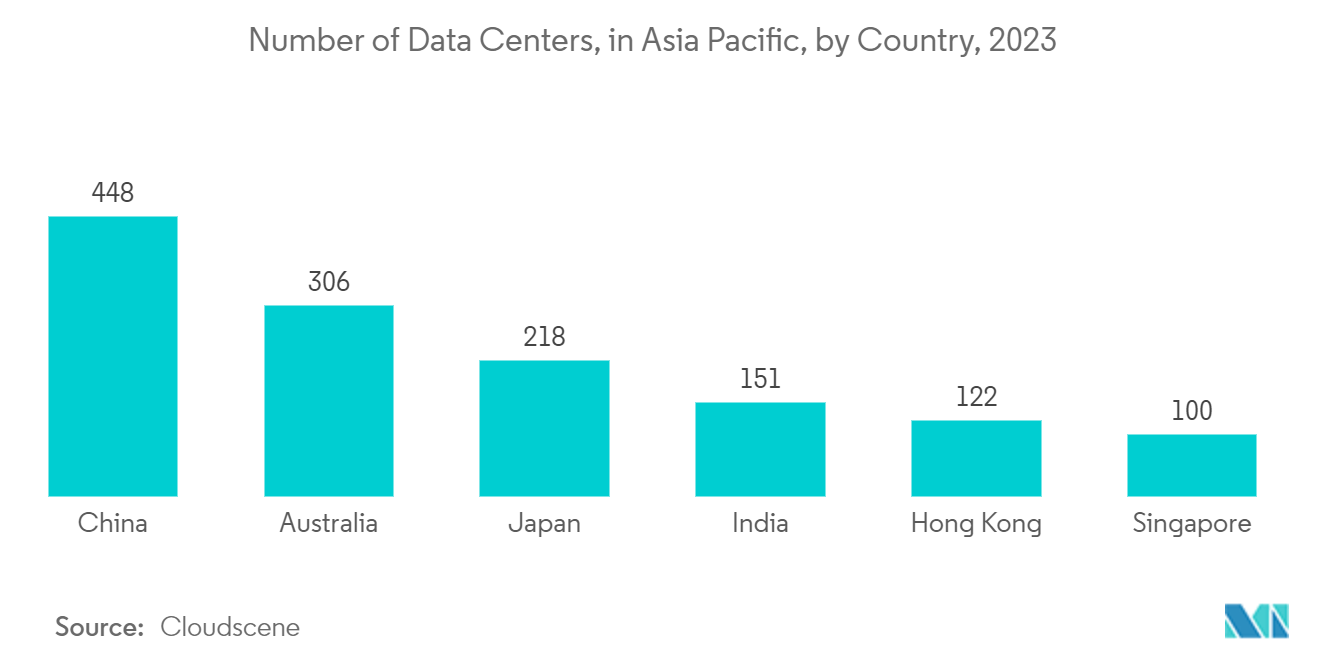
India is Expected to Hold Significant Market Share
- India is a rapidly growing market for technology products and services, including storage solutions like SSD caching. India has undergone significant digital transformation across various industries, including finance, e-commerce, healthcare, and more. As businesses and organizations digitize their operations, there's an increasing need for faster data access and improved application performance, which SSD caching can help.
- The e-commerce sector in India has been expanding increasingly, driven by the rapid use of online shopping and digital transactions. E-commerce platforms require quick data access and responsiveness to deliver a seamless shopping experience, making SSD caching a valuable technology.
- According to the India Brand Equity Foundation, Owing to the growing Internet user base and favorable market conditions, the country has potential in the e-commerce industry. Increasing at an exponential rate, the market value of the e-commerce industry in India was about USD 74.8 billion in 2022. This number is estimated to reach approximately USD 350 billion by 2030.
- The gaming industry in India has been on the rise, with a growing number of gamers and game enthusiasts. SSD caching can significantly improve gaming experiences by reducing load times and improving overall performance.
- The Indian government is focused on initiatives such as "Digital India," and the push for smart cities has led to an increased emphasis on technology adoption. These initiatives require efficient storage solutions to handle the data generated by various digital services.
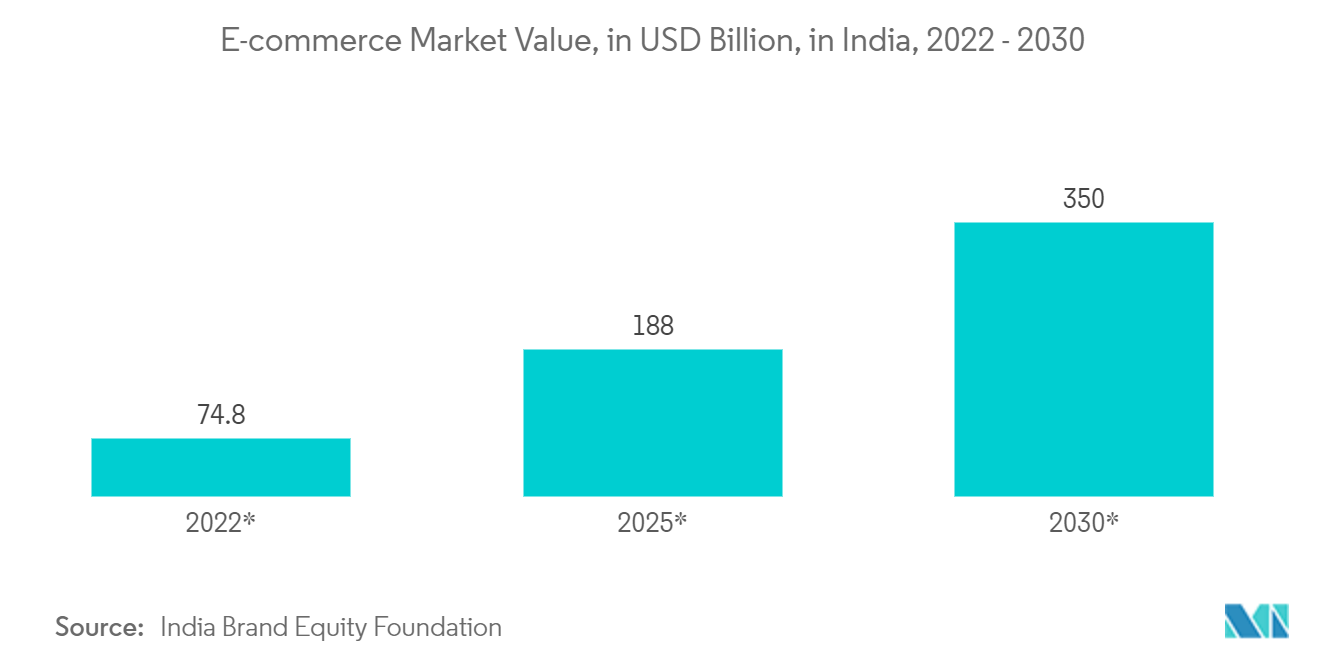
Competitive Landscape
The Asia Pacific SSD Caching market is highly fragmented, with the presence of major players like Intel Corporation, Samsung Electronics Co. Ltd, Micron Technology Inc., Western Digital Corporation, and QNAP Systems Inc. Players in the market are adopting strategies such as partnerships and acquisitions to enhance their product offerings and gain sustainable competitive advantage.
In January 2023, QNAP introduced advanced NAS solutions by adopting a new storage interface and technologies that include the TBS-574X – QNAP’s first all-flash NAS that supports hot-pluggable E1.S NVMe SSDs to fulfill performance-demanding video production with higher serviceability, and the TS-AI642 that features on-device AI with NPUs for boosting image recognition applications and video surveillance.
Asia Pacific SSD Caching Industry Leaders
-
Intel Corporation
-
Samsung Electronics Co. Ltd
-
Micron Technology Inc.
-
Western Digital Corporation
-
QNAP Systems Inc.
- *Disclaimer: Major Players sorted in no particular order
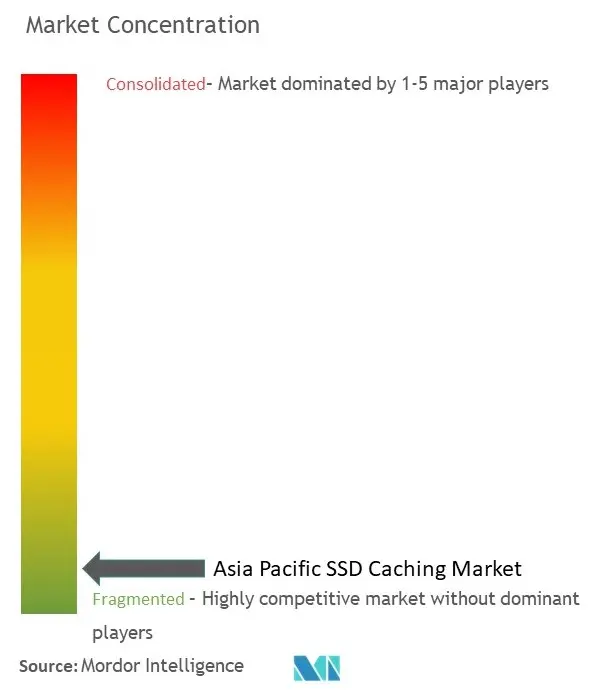
Recent Industry Developments
- July 2023: Lenovo updated ThinkSystem DM5000H can scale up to 1.96 PB of raw storage capacity. A cluster of the DM5000H storage systems can scale up to 23.5 PB for NAS or up to 11.7 PB for SAN environments. The ThinkSystem DM5000H offers unified file and block storage connectivity with support for 1 GbE or 10 GbE NAS and iSCSI and 8 Gb or 16 Gb Fibre Channel protocols simultaneously. Acceleration of read-centric workloads with the high-speed, low-latency onboard NVMe SSD caching.
- January 2023: QNAP Systems, Inc., one of the leading providers of computing, networking, and storage solution innovators, introduced the high-capacity TS-1655 tower 2.5GbE NAS, which can accommodate twelve 3.5-inch hard drives and four 2.5-inch solid-state drives. The TS-1655 integrates 8-core computing power, 2.5GbE high speed, and PCIe expansion to boost business efficiency for cross-team file sharing, collaboration, backup and disaster recovery, and virtualization. It is designed with a hybrid storage architecture that balances performance and cost. With its HDD/SSD hybrid storage architecture, the TS-1655 achieves a cost-performance balance while supporting RAID 50/60, providing high-capacity NAS customers with increased data security and optimal storage space use.
Asia Pacific SSD Caching Market Report Scope
SSD caching, also known as flash caching, is the temporary storage of data on NAND flash memory chips in a solid-state drive (SSD) to allow for a faster response to data requests. In an enterprise IT setting, the purpose of SSD read caching is to store previously requested data as it passes through the network so that it can be retrieved instantly when needed. Placing previously requested information in temporary storage or cache decreases bandwidth usage and speeds up access to the most active data. Caching data on SSDs can be a more cost-effective option than storing data on top-tier flash storage. SSD write caching aims to hold data briefly until slower persistent storage media has enough resources to complete the writing process.
The Asia Pacific SSD caching market is segmented by application (enterprise storage and personal storage) and by country (China, Japan, India, South Korea, and the Rest of Asia Pacific). The market sizes and forecasts are provided in terms of value in USD for all the above segments.
| Enterprise Storage |
| Personal Storage |
| China |
| Japan |
| India |
| South Korea |
| Australia and New Zealand |
| By Application | Enterprise Storage |
| Personal Storage | |
| By Country*** | China |
| Japan | |
| India | |
| South Korea | |
| Australia and New Zealand |
Key Questions Answered in the Report
How big is the Asia Pacific SSD Caching Market?
The Asia Pacific SSD Caching Market size is expected to reach USD 20.61 billion in 2025 and grow at a CAGR of 7.5% to reach USD 29.59 billion by 2030.
What is the current Asia Pacific SSD Caching Market size?
In 2025, the Asia Pacific SSD Caching Market size is expected to reach USD 20.61 billion.
Who are the key players in Asia Pacific SSD Caching Market?
Intel Corporation, Samsung Electronics Co. Ltd, Micron Technology Inc., Western Digital Corporation and QNAP Systems Inc. are the major companies operating in the Asia Pacific SSD Caching Market.
What years does this Asia Pacific SSD Caching Market cover, and what was the market size in 2024?
In 2024, the Asia Pacific SSD Caching Market size was estimated at USD 19.06 billion. The report covers the Asia Pacific SSD Caching Market historical market size for years: 2019, 2020, 2021, 2022, 2023 and 2024. The report also forecasts the Asia Pacific SSD Caching Market size for years: 2025, 2026, 2027, 2028, 2029 and 2030.
Page last updated on:
Asia Pacific SSD Caching Market Report
Statistics for the 2025 Asia Pacific SSD Caching market share, size and revenue growth rate, created by Mordor Intelligence™ Industry Reports. Asia Pacific SSD Caching analysis includes a market forecast outlook for 2025 to 2030 and historical overview. Get a sample of this industry analysis as a free report PDF download.
